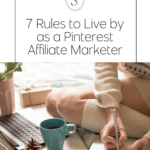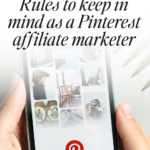
Rules to Live by as a Pinterest Affiliate Marketer
Table of Contents
ToggleSharing is caring!
Reading Time: 4 minutes


Being the 4th most popular social media platform globally, Pinterest has 445 million active users – most of which are women. In fact, almost half of the women in the US are actively using Pinterest, which explains why health, beauty, and art are some of the top categories on the platform.
It’s surprising how under-utilised Pinterest is among marketers despite its popularity. You could earn over $75,000 annually on this platform compared to Facebook, TikTok or Snapchat users. If you’re looking for a great side hustle, we suggest marketing on Pinterest.
Of course, there are rules to keep in mind to drive traffic to your website and earn more passive income. Here are the rules to live by as a Pinterest affiliate marketer:

7 Rules to Live by as a Pinterest Affiliate Marketer
Stick to the Community Guidelines
All social media platforms have rules, and Pinterest is not an exception. Before making money on the platform, familiarise yourself with the rules and stick to them. When you’re sticking to the rules, you can look forward to a steady stream of affiliate income:
Avoid link cloaking: Pinners are expected to be transparent, including where every link will lead users to. Avoid link cloaking and be clear about where the URLs are taking viewers so they can anticipate where users are being taken.
Add a disclaimer for affiliate links: If you use affiliate links, it’s only right to disclose this information to users. Apart from affiliate content, label sponsored content as such in the pin description or on the landing page you are directing users to.
Don’t manipulate the system: Don’t try to create multiple accounts to repin images as a way to manipulate the platform. Pinterest can detect multiple accounts, and you risk being banned from the platform for good.
Experiment with different types of images
Do a quick search on your industry, and you’ll see right away there are different types of visual content on display. Users are not sticking to the same pin type, so don’t be afraid to experiment with other forms of visual content to make your pins stand out. You can do black and white pins, minimalist style, text-heavy, visuals only, etc. There is no rule on what kind of pins work best as long as you are using high-quality images.
Automate Pin Scheduling
Using mental reminders isn’t efficient because if you’re busy, you will likely miss whatever tasks you have for a specific date. Instead of using mental reminders, schedule your pins in advance using an automation tool like Tailwind.
Tailwind lets you schedule and post Pinterest content in advance, so you don’t have to do it manually again. The images on the queue will be pinned to your Pinterest board automatically. By scheduling your pins in advance, you’ll reach more active users. We highly suggest scheduling the pins at different times of the day for maximum exposure. Your newest pins will also likely appear to more viewers once they go online, boosting your online presence.
Implement SEO strategies
Whenever you post new pins, ensure each one is optimised with your primary keyword. Insert the primary keywords into the following:
Pinterest profile: Your account bio should be optimised with your primary keyword along with relevant keywords. For example, if you are promoting beauty products, use terms like “beauty products,” “Skin care products,” “eye makeup,” etc., so your profile will show up to users in the searches.
Pin description: Sprinkle your primary and long-tail keywords all over the pin descriptions. Be mindful of the keyword ratio. Adding “how to” with related keywords helps boost the performance of a pin.
Board Description: Long-tail keywords will work well in the board descriptions. If you’re promoting yoga, for example, use middle-ground keywords like “yoga basics,” “yoga how-tos,” “yoga health tips,” etc.
Check the Metrics
You have to review the metrics to know which of your pins are popular among followers. Here are the values that you need to check:
Clickthrough rate: How many people are viewing and clicking a pin? Which specific pins are getting more clicks than others? Are branded or collab pins getting more attention from users than non-branded content?
Bounce rate: How much time viewers spend on your website or landing page matters. If viewers are not staying on your site for more than two seconds, it’s a sign that your marketing messages are not sticking. You should aim for a low bounce rate and high time spent on your site. How? Start by matching your pins with your landing page content. This ensures you’re marketing your business to the right people.
Conversions: Review your product sales and see which ones sell better, even with minimal promotions. Align your content strategy with your bestsellers to boost your conversion rate.
Use Paid Ads for High Performing Pins
Promoting pins is critical to your marketing campaign, and you should zero in on the highest-performing pins. Check the metrics and see which pins are popular among followers. Promote these pins to a targeted group of people to widen your research. Advertising costs on Pinterest will depend on the pin style, content, and industry you’re in. But the average rates are:
- $2 to $5 CPM
- $0.10 to $1.50 per engagement
- $0.10 to $1.50 per site visitor
Promoting your highest-performing pins on Pinterest via paid ads will drive more traffic to your website, earn more, and build a stronger online presence.
Maximise Group Boards
Pinning on your boards is not enough. Look for relevant group boards and start adding your pins. Group boards are community-style boards that let users share relevant content on one board. The goal is to share target audiences and build brand awareness.
A quick search on Pinterest and you’ll find dozens of boards in various industries. If you’re selling nail polishes, for example, use the search words “beauty nail products group,” “nail polish groups,” “group nails, nail lacquer, nail polish,” etc. Read the group guidelines on becoming contributors; many require you to follow the group board creator to add pins. Once you’ve become a contributor, you can either post pins with affiliate links (if the creator allows) or post blog or video content as landing pages.
Generating passive income as a Pinterest affiliate marketer has its challenges, but as long as you’re consistently putting out quality pins, you will achieve your marketing goals in no time at all. With these tips, we hope to inspire you to use Pinterest for maximum affiliate profits.
Most Popular Posts:
Sharing is caring!
[…] makes Pinterest the perfect place for affiliate marketing? Here are just some of the many reasons why Pinterest […]